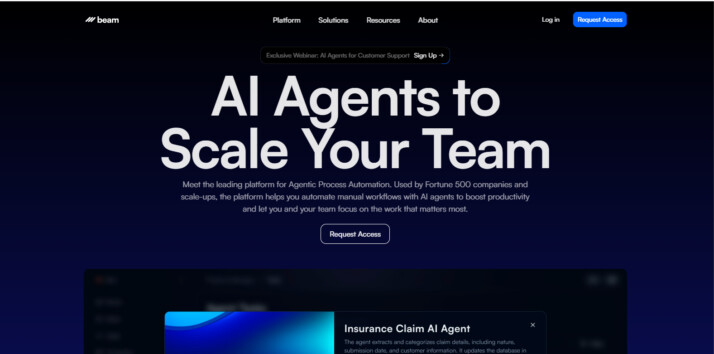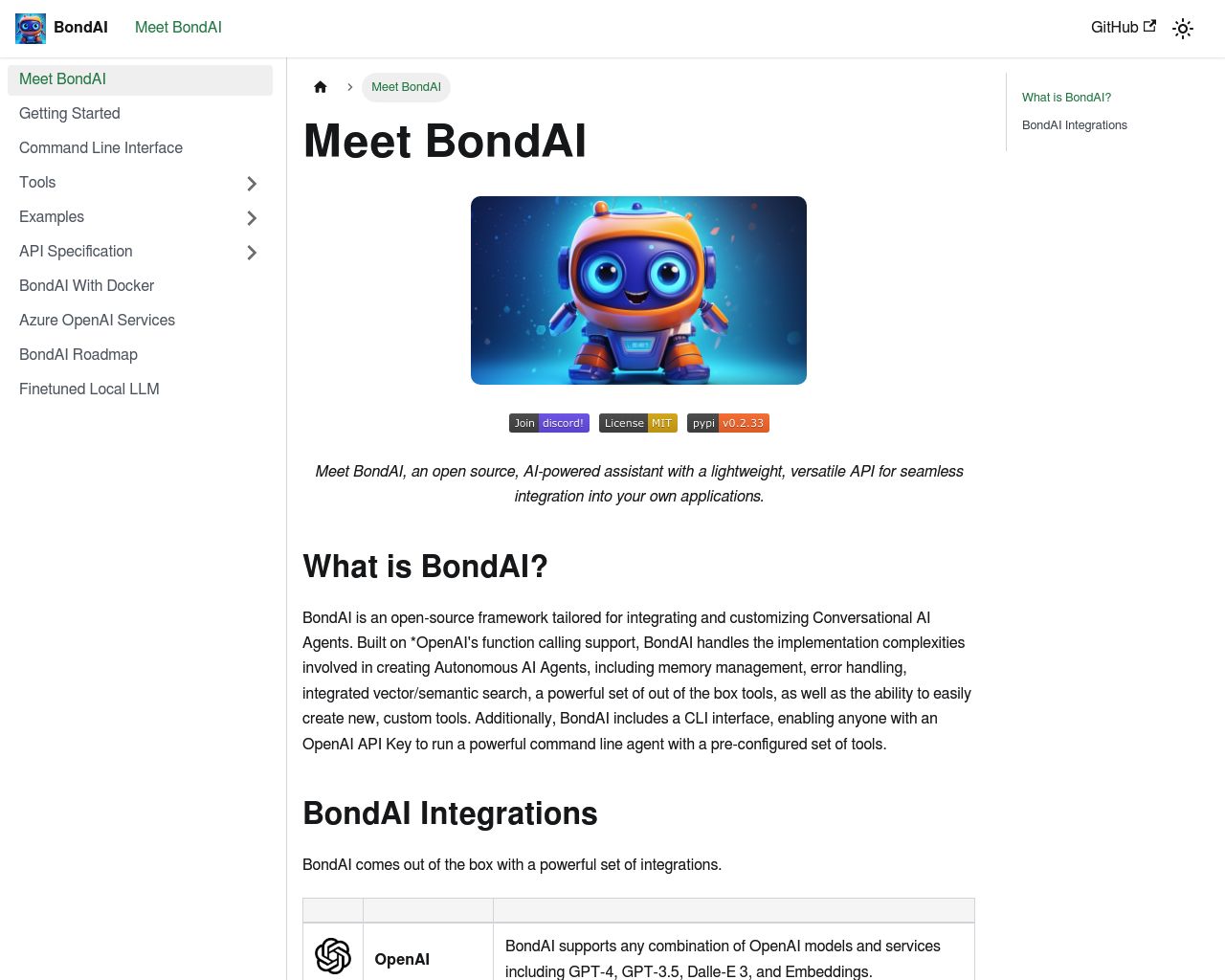Beam AI vs. BondAI: Comparing Enterprise and Open-Source AI Platforms
AI agent platforms revolutionize workflow automation and problem-solving capabilities across industries. This comparison explores Beam AI’s enterprise-focused autonomous agents, BondAI’s flexible open-source framework, and SmythOS’s comprehensive solution. We examine each platform’s strengths in areas like scalability, integration, and user accessibility. Developers will discover API capabilities and customization options, while business leaders gain insights into security features and deployment flexibility. For non-technical users, we highlight no-code tools and pre-built templates. Whether you’re building complex AI systems or seeking to streamline operations, this analysis provides the information needed to choose the right AI agent platform for your specific needs.
Beam AI Overview
Beam AI specializes in developing generative AI agents that automate repetitive tasks and enhance organizational productivity. Beam AI creates autonomous Agentic Process Automations (APAs) that execute workflows more efficiently than human workers, continuously learning and adapting to improve performance over time.


Beam AI Website Screenshot
These AI agents excel in areas like data processing, customer service automation, compliance task management, and order optimization. Beam AI’s platform supports both cloud and on-premises deployment options, providing flexibility for development and production environments. The agents integrate seamlessly with existing internal systems, allowing for comprehensive workflow planning and execution.
Beam AI creates autonomous Agentic Process Automations (APAs) that execute workflows more efficiently than human workers, continuously learning and adapting to improve performance over time.
Beam AI emphasizes explainability and transparency in its AI solutions. Users can understand and control agent behavior, ensuring operations align with organizational policies. The platform includes robust logging and monitoring features for tracking agent activities and optimizing performance. Security measures like data encryption and OAuth authentication protect sensitive information and control access.
While Beam AI offers powerful AI agent capabilities, it lacks certain features found in some competitors. The platform does not include a visual builder or no-code editor for creating agents, which may limit accessibility for non-technical users. Additionally, there’s no mention of multimodal capabilities or a hosted vector database for managing large-scale data. Despite these limitations, Beam AI’s focus on intelligent, adaptable agents positions it as a strong contender for organizations seeking to automate complex workflows and boost operational efficiency.
BondAI Overview
BondAI offers an open-source framework for developing AI Agent Systems. The platform simplifies complex aspects of creating autonomous AI agents, such as memory management, error handling, and semantic search. BondAI integrates a wide range of tools and services, providing versatile features out-of-the-box.


The framework supports advanced AI architectures like ReAct Agents and ConversationalAgents, enabling both individual interactions and multi-agent systems. These capabilities allow BondAI to tackle complex tasks that surpass single-agent models. The platform seamlessly integrates with popular services including OpenAI models, Microsoft Azure, Google Search, and LangChain, making it a powerful tool for various applications from research to customer support.
BondAI offers an open-source framework for developing AI Agent Systems. The platform simplifies complex aspects of creating autonomous AI agents, such as memory management, error handling, and semantic search.
BondAI’s robust memory management system, inspired by the MemGPT paper, uses a tiered approach for handling extensive contexts and complex conversations. This structure efficiently manages and retrieves information, enhancing the agents’ problem-solving abilities. The platform offers flexibility in implementation, allowing users to work via CLI, Docker containers, or direct integration into codebases.
While BondAI provides a comprehensive toolkit for AI agent development, it lacks some features found in other platforms. The absence of a visual builder or no-code editor may limit accessibility for non-technical users. Additionally, there’s no mention of a hosted vector database or specialized crawlers for sitemaps, YouTube transcripts, or URLs, which could restrict certain data gathering capabilities.
Despite these limitations, BondAI’s combination of advanced AI research, extensive tool integration, and flexible implementation options makes it a strong choice for developers and researchers aiming to build powerful AI-driven applications. Its open-source nature also allows for community contributions and customizations, potentially offsetting some of its current limitations.
Feature Comparison
Beam AI and BondAI offer distinct approaches to AI agent development, each with its own strengths and limitations. Beam AI excels in creating autonomous agents for complex workflow automation, while BondAI provides an open-source framework for building versatile AI systems.
Beam AI’s platform focuses on enterprise-grade solutions, offering robust security features like data encryption and OAuth authentication. Its agents excel at handling large-scale tasks, with built-in scheduling and monitoring capabilities. However, Beam AI lacks a visual builder or no-code editor, potentially limiting accessibility for non-technical users.
BondAI, as an open-source framework, offers greater flexibility for developers. It supports advanced AI architectures like ReAct Agents and multi-agent systems, enabling sophisticated problem-solving capabilities. BondAI’s memory management system, inspired by recent research, allows for efficient handling of extensive contexts. However, BondAI doesn’t provide hosted solutions or built-in deployment options, requiring more technical expertise to implement and scale.
Neither platform offers a hosted vector database or specialized crawlers for data gathering, which SmythOS provides. SmythOS combines the strengths of both platforms, offering a user-friendly visual builder, robust security features, and advanced AI capabilities in a comprehensive, scalable solution.
Feature Comparison Table
| Beam AI | BondAI | SmythOS | |
|---|---|---|---|
| CORE FEATURES | |||
| Visual Builder | ❌ | ❌ | ✅ |
| No-Code Options | ❌ | ❌ | ✅ |
| Debug Tools | ❌ | ✅ | ✅ |
| Multimodal | ❌ | ✅ | ✅ |
| Audit Logs for Analytics | ✅ | ❌ | ✅ |
| SECURITY | |||
| Constrained Alignment | ✅ | ❌ | ✅ |
| IP Control | ✅ | ❌ | ✅ |
| COMPONENTS | |||
| Data Lakes | ❌ | ❌ | ✅ |
| DEPLOYMENT OPTIONS (EMBODIMENTS) | |||
| Staging Domains | ✅ | ❌ | ✅ |
| Deploy as Scheduled Agent | ✅ | ❌ | ✅ |
| DATA LAKE SUPPORT | |||
| Hosted Vector Database | ❌ | ❌ | ✅ |
| Sitemap Crawler | ❌ | ❌ | ✅ |
| YouTube Transcript Crawler | ❌ | ❌ | ✅ |
| URL Crawler | ❌ | ✅ | ✅ |
Best Alternative to Beam AI and BondAI
SmythOS stands out as the superior alternative to Beam AI and BondAI, offering a comprehensive platform for AI agent development and deployment. We combine the strengths of both competitors while addressing their limitations, providing a user-friendly yet powerful solution for businesses and developers alike.
Our visual builder sets us apart, enabling users to create complex AI workflows without extensive coding knowledge. This democratizes AI development, making it accessible to a broader audience while still offering the depth and flexibility that experienced developers require. Unlike Beam AI and BondAI, SmythOS provides a no-code editor, allowing non-technical users to harness the power of AI for their specific needs.
SmythOS stands out as the superior alternative to Beam AI and BondAI, offering a comprehensive platform for AI agent development and deployment.
We excel in scalability and deployment options, offering hosted agents for both development and production environments. This flexibility allows for seamless integration into existing systems and workflows, a critical feature that BondAI lacks. Our platform supports multi-agent collaboration and human-AI interaction, enabling sophisticated problem-solving capabilities that surpass those of Beam AI.
Security is a top priority for SmythOS. We offer robust features like data encryption, OAuth authentication, and IP control, matching the enterprise-grade security of Beam AI while providing the flexibility and openness that BondAI users appreciate. Our constrained alignment feature ensures that AI agents operate within defined parameters, addressing ethical concerns and regulatory requirements.
Unlike our competitors, SmythOS provides a hosted vector database and specialized crawlers for efficient data gathering and processing. These features, combined with our support for various data formats and integration capabilities, make our platform the ideal choice for businesses looking to leverage AI across diverse applications and industries.
Conclusion
Beam AI, BondAI, and SmythOS each offer unique approaches to AI agent development, catering to different needs and technical expertise levels. Beam AI excels in enterprise-grade workflow automation with robust security features, while BondAI provides an open-source framework for building versatile AI systems with advanced architectures.
However, SmythOS stands out as the superior choice, combining the strengths of both platforms and addressing their limitations. Our drag-and-drop interface and no-code editor make AI agent creation accessible to both technical and non-technical users. We offer a comprehensive suite of features, including hosted agents, multimodal capabilities, and a vast integration ecosystem of over 300,000 connections.
Unlike Beam AI and BondAI, SmythOS provides a hosted vector database and supports specialized crawlers, enhancing data gathering and management capabilities. Our platform also excels in scalability, offering flexible deployment options across various environments and services. This versatility, combined with our robust security measures and transparent AI operations, makes SmythOS ideal for businesses of all sizes seeking to harness the power of AI.
To experience the full potential of AI agent development and deployment, create a free SmythOS account today. Explore our diverse range of AI-powered agent templates to jumpstart your projects, and leverage our extensive documentation for in-depth platform insights. With SmythOS, you’ll revolutionize your workflow and unlock unprecedented levels of automation and efficiency.
Last updated:
Disclaimer: The information presented in this article is for general informational purposes only and is provided as is. While we strive to keep the content up-to-date and accurate, we make no representations or warranties of any kind, express or implied, about the completeness, accuracy, reliability, suitability, or availability of the information contained in this article.
Any reliance you place on such information is strictly at your own risk. We reserve the right to make additions, deletions, or modifications to the contents of this article at any time without prior notice.
In no event will we be liable for any loss or damage including without limitation, indirect or consequential loss or damage, or any loss or damage whatsoever arising from loss of data, profits, or any other loss not specified herein arising out of, or in connection with, the use of this article.
Despite our best efforts, this article may contain oversights, errors, or omissions. If you notice any inaccuracies or have concerns about the content, please report them through our content feedback form. Your input helps us maintain the quality and reliability of our information.
